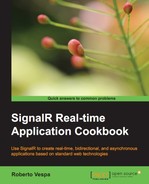In this chapter, we will cover the following recipes:
- Adding and registering a persistent connection
- Sending messages from the server
- Sending messages to the server
- Exchanging messages between a server and a JavaScript client
- Exchanging messages between a server and a .NET client
In our journey through all the features exposed by SignalR, so far we have been analyzing and dissecting how we can use the Hubs API to deliver real-time, bidirectional messaging inside our applications. The Hubs API offers a high-level abstraction over the underlying connection, effectively introducing a Remote Procedure Call (RPC) model on top it. SignalR is also offering a low-level API, which is the foundation Hubs is built on top of. However, it's also available to be used directly from inside our applications and it's called the Persistent Connection API.
A Persistent Connection API is a more basic representation of what the concrete network connection really is, and exposes a simpler and rawer API to interact with. We hook into this API by inheriting from a base class (PersistentConnection) in order to add our own custom Persistent Connection manager. It is the same approach we have been using when defining our custom Hubs by deriving from the Hub class. Through a registration step, we'll then let SignalR know about our custom type in order to expose it to our clients.
The PersistentConnection type exposes a few properties supplying entry points from where we send messages to the connected clients, and a set of overridable methods we can use to hook into the connection and messaging pipeline in order to handle the incoming traffic. This chapter will be an introduction to the Persistent Connection API, hence we'll be looking at just a portion of it in order to deliver some basic functionalities. We will also try to highlight what the peculiar attributes of this API are, which characterize it as a low-level one—still delivering powerful features, but without some of the nice mechanisms we have for free when using the Hubs API.
For the next four recipes, we will always start with empty web application projects, and we'll use simple HTML pages for the client portions. However, for the last one, we'll be building a console application. As usual, if you want more information on these steps, you can refer to Appendix A, Creating Web Projects, at the end of the book.
